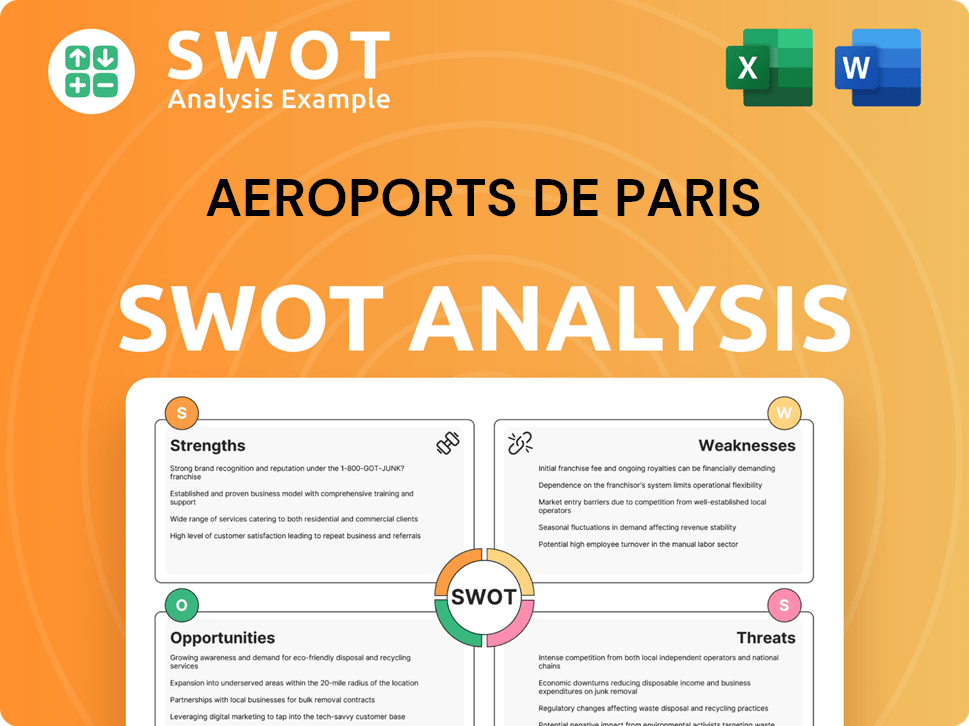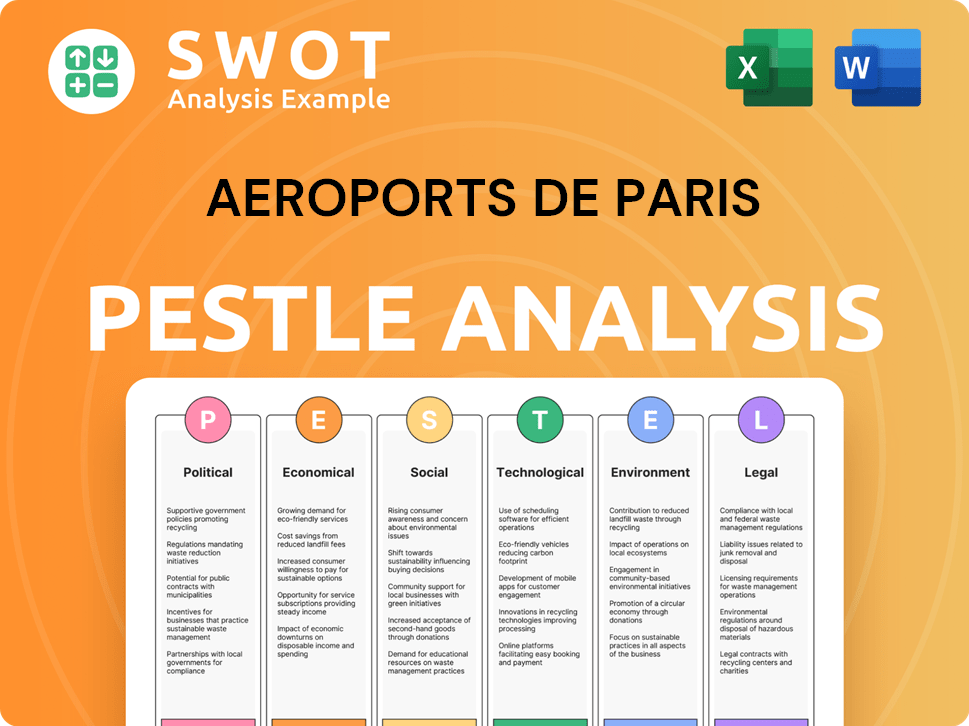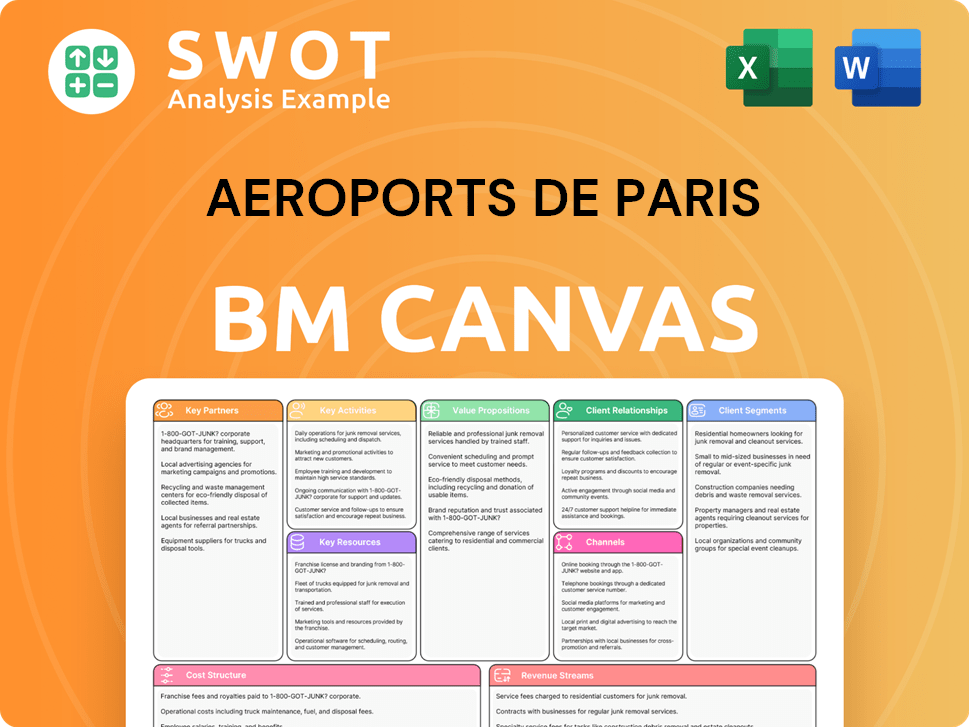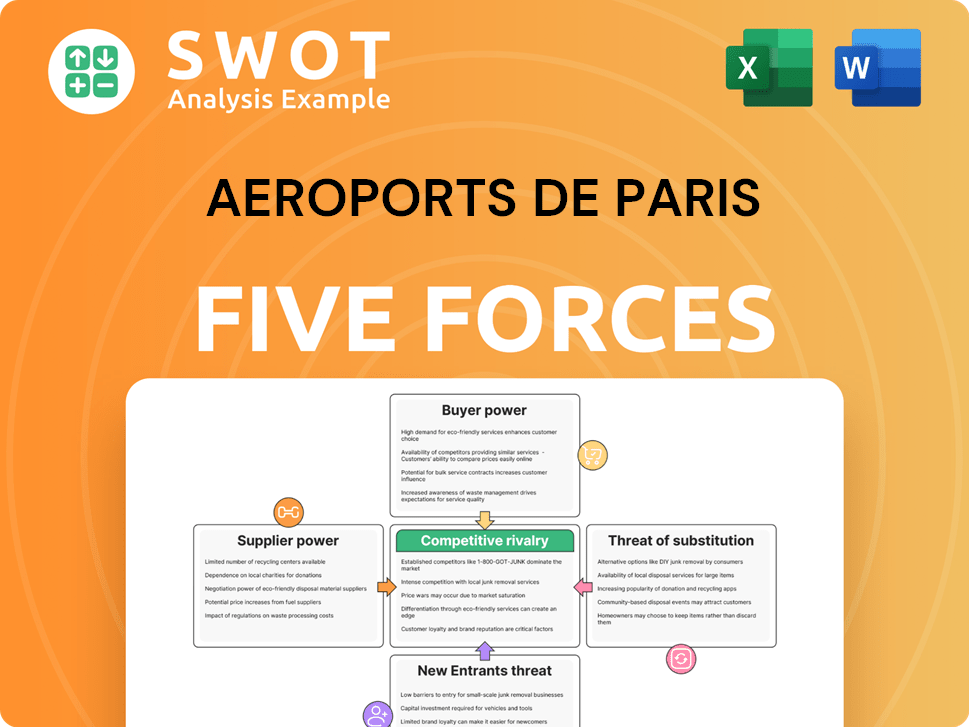Aeroports de Paris Bundle
Can Aeroports de Paris Maintain Its Ascent in the Aviation Industry?
Aéroports de Paris (ADP), a titan in the global aviation sector, manages the bustling Paris airports, including Charles de Gaulle and Orly. With a history dating back to 1945, ADP has evolved into a leading international airport operator. In 2024, ADP's network saw a significant surge in passenger traffic, demonstrating its robust market position and potential.

This exploration delves into the Aeroports de Paris SWOT Analysis, examining ADP's growth strategy and future prospects. We'll dissect ADP's strategic roadmap, '2025 Pioneers,' and analyze its plans for expansion, innovation, and sustainable growth. Understanding ADP's ADP financial performance and ADP passenger traffic statistics are key to grasping its long-term potential and ADP investment opportunities.
How Is Aeroports de Paris Expanding Its Reach?
The expansion initiatives of Aeroports de Paris (ADP) are central to its ADP growth strategy, focusing on sustainable growth and a broader global footprint. The company is actively pursuing international expansion. This strategy leverages subsidiaries like TAV Airports and GMR Airports to increase its presence in key markets.
In 2024, the International and Airport Developments segment saw a significant revenue increase, demonstrating the success of this expansion. This focus is expected to drive future earnings growth, particularly as passenger traffic in Paris approaches pre-pandemic levels.
A key element of ADP's strategy is the 'Extime' retail and hospitality concept, aimed at enhancing the passenger experience and boosting customer satisfaction. This initiative includes the Extime Paris terminal at Paris-CDG, which has shown promising results.
ADP's international expansion is primarily driven by subsidiaries like TAV Airports and GMR Airports. In 2024, the International and Airport Developments segment saw a 20.9% increase in revenue, reaching €1,971 million. This growth is expected to be a key driver for future earnings.
The 'Extime' retail and hospitality concept aims to create more value for passengers and increase customer satisfaction. At Extime Paris, spend per passenger reached €32.1 in 2024, a 4.9% increase. For 2025, Extime Paris spend per pax is expected to grow between 4.0% and 6.0% compared to 2023.
ADP is also focused on strengthening its infrastructure to meet evolving traffic trends and support the aviation sector's ecological transition. This includes adapting Paris Aéroport's capacity to growing intermodality, with a public consultation for Paris-Orly initiated in February 2024. ADP is investing in infrastructure to support its long-term growth and sustainability goals.
- Average yearly investment spending (capex) for 2025 is projected to be up to €1 billion for ADP SA.
- The Group's capex is projected to be €1.4 billion for 2025.
- These investments are crucial for maintaining and enhancing airport capacity.
- They also support the company's commitment to environmental sustainability.
Aeroports de Paris SWOT Analysis
- Complete SWOT Breakdown
- Fully Customizable
- Editable in Excel & Word
- Professional Formatting
- Investor-Ready Format

How Does Aeroports de Paris Invest in Innovation?
The innovation and technology strategy of Aeroports de Paris (ADP) is central to its ADP growth strategy and future prospects. ADP leverages technology and innovation to drive sustained growth. This includes a strong focus on digital transformation, automation, and sustainability initiatives, all of which are key to the company's long-term vision.
The '2025 Pioneers' strategic roadmap highlights ADP's commitment to transforming its airports into multimodal and energy hubs. This transformation involves creating spaces that enhance connectivity and integrate various modes of travel, with rail-air connections playing a significant role in the development of its hubs. These hubs are also designed to lead the deployment of new clean energies and utilize innovative, environmentally friendly construction methods.
While specific details on R&D investments and key patents are not extensively highlighted in recent reports, ADP's commitment to innovation is evident in its strategic shift towards a sustainable airport model. The company aims for excellence in hospitality and fluidity for its passenger customers, as well as operational and environmental performance for its airline customers. This multi-local approach to a culture of innovation and responsibility is central to its operations, ensuring that ADP remains competitive in the evolving landscape of the airport operator industry.
ADP's focus on innovation is multifaceted, incorporating digital transformation, automation, and sustainability. These initiatives are designed to enhance passenger experience, improve operational efficiency, and reduce environmental impact. The goal is to create a modern, efficient, and sustainable airport ecosystem.
- Digital Transformation: Implementing digital solutions to improve passenger flow, enhance services, and streamline operations. This includes mobile applications, digital signage, and data analytics to optimize airport management.
- Automation: Utilizing automation technologies to enhance efficiency in baggage handling, security checks, and other operational areas. This reduces labor costs and improves the overall passenger experience.
- Sustainability Initiatives: Investing in renewable energy sources, reducing carbon emissions, and implementing eco-friendly construction methods. This includes the use of electric vehicles, sustainable building materials, and waste management programs.
- Multimodal Hubs: Integrating various modes of transport, such as rail and air, to create seamless travel experiences. This involves developing infrastructure to connect airports with high-speed rail networks and other transportation options.
- Energy Hubs: Deploying new clean energies and innovative construction methods. This includes solar panel installations, energy-efficient buildings, and the use of sustainable materials.
Aeroports de Paris PESTLE Analysis
- Covers All 6 PESTLE Categories
- No Research Needed – Save Hours of Work
- Built by Experts, Trusted by Consultants
- Instant Download, Ready to Use
- 100% Editable, Fully Customizable

What Is Aeroports de Paris’s Growth Forecast?
In 2024, Aéroports de Paris (ADP) demonstrated robust financial health, achieving all its financial objectives. The company's consolidated revenue reached a record high of €6,158 million, marking a 12.1% increase year-over-year. This growth was primarily fueled by increased traffic and strong performance in retail activities, showcasing the effectiveness of its ADP growth strategy.
Recurring EBITDA for 2024 reached €2,068 million, a 5.7% rise, exceeding expectations due to the contributions from TAV Airports. The attributable net income was €342 million, but excluding one-off items, it stood at €638 million. These results reflect ADP's strong operational efficiency and strategic financial management.
Looking ahead to 2025, ADP has confirmed its financial outlook, indicating continued growth and strategic investments. The company anticipates further expansion and enhanced financial performance, supported by key initiatives and market trends.
Consolidated revenue for 2024 reached €6,158 million, a 12.1% increase year-on-year. This growth was primarily driven by traffic growth and strong retail activities.
Recurring EBITDA for 2024 topped €2,068 million, up 5.7%, surpassing targets. This was due to the performance of TAV Airports, demonstrating strong operational efficiency.
Traffic forecasts for Paris Aéroport anticipate annual growth between 2.5% and 4.0% in 2025. This indicates a positive outlook for passenger numbers.
Spend per passenger for Extime Paris is expected to grow between 4.0% and 6.0% compared to 2023, reaching €31.8 to €32.4, enhancing revenue from retail activities.
Recurring EBITDA is projected to grow by over 7.0% in 2025, reflecting continued operational improvements and strategic financial planning. This indicates strong ADP financial performance.
The net debt to recurring EBITDA ratio is expected to remain in the target range of 3.5x to 4.0x, ensuring financial stability and responsible debt management. This supports ADP's long term growth forecast.
The average yearly investment spending (capex) for 2025 is forecast to be up to €1 billion for ADP SA and €1.4 billion for the Group as a whole. These investments support future expansion and infrastructure development, key elements of Aeroports de Paris expansion plans.
ADP's dividend policy remains a payout ratio of 60% of attributable net income, with a proposed dividend of €3.00 per share for 2024. This demonstrates commitment to shareholder value.
The approval of airport fees for the 2025 tariff period, representing a 4.5% rise on average, is a positive financial indicator. This supports the company's revenue generation.
These financial projections and strategic initiatives underscore ADP's commitment to sustainable growth and value creation. These goals align with ADP's strategic goals and highlight ADP's future prospects.
Aeroports de Paris Business Model Canvas
- Complete 9-Block Business Model Canvas
- Effortlessly Communicate Your Business Strategy
- Investor-Ready BMC Format
- 100% Editable and Customizable
- Clear and Structured Layout

What Risks Could Slow Aeroports de Paris’s Growth?
Aéroports de Paris (ADP), as an airport operator, faces several risks that could affect its ADP growth strategy and future prospects. These challenges include market competition, regulatory changes, and the rapid pace of technological advancements. These factors can significantly influence the company's financial performance and its ability to achieve its strategic goals.
One of the primary challenges for ADP is the potential slowdown in passenger traffic growth in Paris, with expectations of only 1.0% to 1.5% growth, which is half of the pre-pandemic growth. This slower growth rate can be attributed to various factors, including the increasing use of sustainable aviation fuel, which may raise ticket prices and potentially reduce demand. Moreover, supply chain vulnerabilities and technological disruptions pose additional risks, requiring continuous adaptation and investment.
Internal resource constraints, such as the need to upskill payroll staff and adapt operations to changing global working conditions, are also noted. The company emphasizes financial discipline through a controlled investment policy, ensuring that over 50% of investments are allocated to asset maintenance and safety and security. Despite these challenges, ADP aims to mitigate risks through a diversified portfolio, including international platforms like TAV Airports and Jordan Airport International Group, which are expected to drive future earnings growth.
The aviation industry is highly competitive, with numerous airport operators and airlines vying for market share. Regulatory changes, such as environmental policies and security requirements, can significantly impact ADP's operational costs and strategic goals. These factors can affect the company's ability to maintain its competitive edge and achieve its financial targets.
ADP faces challenges in balancing environmental goals with traffic volume. The slower expected traffic growth of 1.0% to 1.5% in Paris, compared to pre-pandemic levels, highlights the need for strategic planning. The increasing use of sustainable aviation fuel, which may increase ticket prices, could further impact demand and the company's revenue streams.
Technological advancements, including AI, require continuous upgrades and enhancements to services. Failure to adapt quickly could diminish demand for their solutions. Investments in product development and new technologies often have a long return on investment cycle, with no guarantee of market acceptance. The company's digital transformation initiatives are crucial.
Disruptions in the supply chain can affect ADP's operations, causing delays and increased costs. These vulnerabilities can impact the company's ability to maintain its infrastructure and provide services effectively. The company must address these risks to ensure operational efficiency and meet its strategic goals.
Upskilling payroll staff and adapting to changing global working conditions are essential for operational efficiency. ADP must allocate resources to training and development to ensure its workforce is prepared to meet evolving industry demands. This includes adapting to new technologies and maintaining a skilled workforce capable of managing complex operations.
The negative outlook on France's sovereign rating could impact ADP's credit ratings. Financial discipline is crucial, with over 50% of investments allocated to asset maintenance and safety. These factors can influence the company's ability to secure funding and maintain its financial stability. For more details on ADP's revenue streams, see Revenue Streams & Business Model of Aeroports de Paris.
ADP's diversified portfolio, including international platforms like TAV Airports and Jordan Airport International Group, aims to mitigate risks. These international projects are expected to drive future earnings growth. The company’s strategic focus includes expanding its presence in key international markets to reduce reliance on the Parisian market and enhance its overall financial performance. This diversification strategy is crucial for long-term growth.
ADP's controlled investment policy ensures that over 50% of investments are allocated to asset maintenance and safety and security. This financial discipline is essential for maintaining operational efficiency and ensuring the long-term sustainability of its infrastructure. The focus on strategic investments is a key component of its ADP financial performance.
Aeroports de Paris Porter's Five Forces Analysis
- Covers All 5 Competitive Forces in Detail
- Structured for Consultants, Students, and Founders
- 100% Editable in Microsoft Word & Excel
- Instant Digital Download – Use Immediately
- Compatible with Mac & PC – Fully Unlocked

Related Blogs
- What are Mission Vision & Core Values of Aeroports de Paris Company?
- What is Competitive Landscape of Aeroports de Paris Company?
- How Does Aeroports de Paris Company Work?
- What is Sales and Marketing Strategy of Aeroports de Paris Company?
- What is Brief History of Aeroports de Paris Company?
- Who Owns Aeroports de Paris Company?
- What is Customer Demographics and Target Market of Aeroports de Paris Company?
Disclaimer
All information, articles, and product details provided on this website are for general informational and educational purposes only. We do not claim any ownership over, nor do we intend to infringe upon, any trademarks, copyrights, logos, brand names, or other intellectual property mentioned or depicted on this site. Such intellectual property remains the property of its respective owners, and any references here are made solely for identification or informational purposes, without implying any affiliation, endorsement, or partnership.
We make no representations or warranties, express or implied, regarding the accuracy, completeness, or suitability of any content or products presented. Nothing on this website should be construed as legal, tax, investment, financial, medical, or other professional advice. In addition, no part of this site—including articles or product references—constitutes a solicitation, recommendation, endorsement, advertisement, or offer to buy or sell any securities, franchises, or other financial instruments, particularly in jurisdictions where such activity would be unlawful.
All content is of a general nature and may not address the specific circumstances of any individual or entity. It is not a substitute for professional advice or services. Any actions you take based on the information provided here are strictly at your own risk. You accept full responsibility for any decisions or outcomes arising from your use of this website and agree to release us from any liability in connection with your use of, or reliance upon, the content or products found herein.